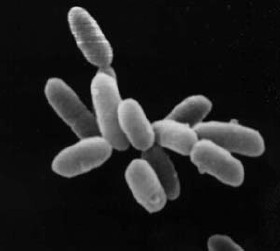A halophile is an extremophile that thrives in high salt concentrations. In chemical terms, halophile refers to a Lewis acidic species that has some ability to extract halides from other chemical species.
The year 1993 in science and technology involved many significant events, listed below.

Halobacterium is a genus in the family Halobacteriaceae.

Haloarchaea are a class of the Euryarchaeota, found in water saturated or nearly saturated with salt. Halobacteria are now recognized as archaea rather than bacteria and are one of the largest groups. The name 'halobacteria' was assigned to this group of organisms before the existence of the domain Archaea was realized, and while valid according to taxonomic rules, should be updated. Halophilic archaea are generally referred to as haloarchaea to distinguish them from halophilic bacteria.

In taxonomy, Haloferax is a genus of the Haloferacaceae.
Halocins are bacteriocins produced by halophilic Archaea and a type of archaeocin.
Exosortase refers to a family of integral membrane proteins that occur in Gram-negative bacteria that recognizes and cleaves the carboxyl-terminal sorting signal PEP-CTERM. The name derives from a predicted role analogous to sortase, despite the lack of any detectable sequence homology, and a strong association of exosortase genes with exopolysaccharide or extracellular polymeric substance biosynthesis loci. Many archaea have an archaeosortase, homologous to exosortases rather than to sortases. Archaeosortase A recognizes the signal PGF-CTERM, found at the C-terminus of some archaeal S-layer proteins. Following processing by archaeosortase A, the PGF-CTERM region is gone, and a prenyl-derived lipid anchor is present at the C-terminus instead.
An archaeosortase is a protein that occurs in the cell membranes of some archaea. Archaeosortases recognize and remove carboxyl-terminal protein sorting signals about 25 amino acids long from secreted proteins. A genome that encodes one archaeosortase may encode over fifty target proteins. The best characterized archaeosortase target is the Haloferax volcanii S-layer glycoprotein, an extensively modified protein with O-linked glycosylations, N-linked glycosylations, and a large prenyl-derived lipid modification toward the C-terminus. Knockout of the archaeosortase A (artA) gene, or permutation of the motif Pro-Gly-Phe (PGF) to Pro-Phe-Gly in the S-layer glycoprotein, blocks attachment of the lipid moiety as well as blocking removal of the PGF-CTERM protein-sorting domain. Thus archaeosortase appears to be a transpeptidase, like sortase, rather than a simple protease.

Haloferax volcanii is a species of organism in the genus Haloferax in the Archaea.
Haloferax larsenii is a gram-negative, aerobic, neutrophilic, extremely halophilic archaeon. It was named in honor of Professor Helge Larsen, who pioneered research on halophiles.

Francisco Juan Martínez Mojica is a Spanish molecular biologist and microbiologist at the University of Alicante in Spain. He is known for his discovery of repetitive, functional DNA sequences in bacteria which he named CRISPR. These were later developed into the first widespread genome editing tool, CRISPR-Cas9.

Haloferacaceae is a family of halophilic, chemoorganotrophic or heterotrophic archaea within the order Haloferacales. The type genus of this family is Haloferax. Its biochemical characteristics are the same as the order Haloferacales.
Haloferax sulfurifontis is a species of archaea in the family Haloferacaceae.
Haloferax alexandrinus is a species of archaea in the family Haloferacaceae.
Haloferax elongans is a species of archaea in the family Haloferacaceae.
Haloferax gibbonsii is a species of archaea in the family Haloferacaceae.

Haloferax mediterranei is a species of archaea in the family Haloferacaceae.
Haloferax mucosum is a species of archaea in the family Haloferacaceae.
Haloferacales is an order of halophilic, chemoorganotrophic or heterotrophic archaea within the class Haloarchaea. The type genus of this order is Haloferax.




